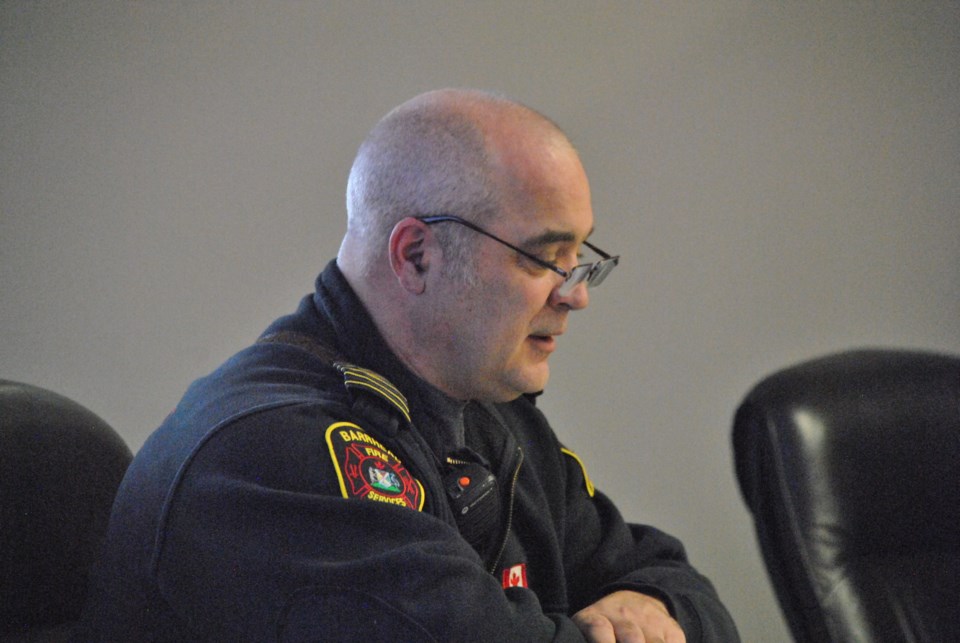BARRHEAD - Medical assistance calls continued to lead the way for Barrhead Regional Fire Services (BRFS) responses for the fourth quarter of 2022.
While presenting his quarterly report for October, November and December to County of Barrhead councillors on Feb. 21, Barrhead Regional Fire Services (BRFS) chief Gary Hove as part of his quarterly report covering October, November and December said that medical calls easily outpaced all other categories of responses.
In the last three months of 2022, BRFS responded to a total of 47 medical assistance calls for a total of 39 hours and 10 minutes of firefighter time.
The bulk of those calls, 34, came from within the Town of Barrhead's borders accounting for 18 hours and 23 minutes of firefighter time, while 13 came from the county and accounted for 16 hours and 47 minutes of firefighter time.
Alarm or fire investigations accounted for the next highest category at 28 calls. Again the town led the way with 21, accounting for 10 hours and 47 minutes of firefighter time compared to seven calls in the county for five hours of firefighters' time.
Fire response, which includes farm equipment fires, was the next highest category, with nine responses. Three came from the county, accounting for 30 hours and 19 minutes of firefighter time, compared to two in the town for three hours and 34 minutes of firefighter time.
The miscellaneous category, including motor vehicle collisions and obstructions/hazards such as downed powerlines, was next with eight calls for six hours and 33 minutes of firefighter time. Five came from within the town's borders for three hours and 40 minutes of firefighter time compared to two in the county for two hours and 53 minutes of firefighter’s time.
Wildland or grass fires were the least reported category, not including motor vehicle collisions or mutual aid responses at four calls split evenly between the municipalities. The calls in the town accounted for just one hour and four minutes of firefighters' time compared to four hours and four minutes in the county.
The final aforementioned categories of motor vehicle collisions and mutual aid requests are kept separately as in the majority of cases, funding for responses comes from either Alberta Transportation in the case of numbered highways or their mutual aid partners.
Firefighters responded to seven motor vehicle collisions, all in the county, accounting for 13 hours and 10 minutes of firefighter time, while mutual aid requests accounted for two hours and 20 minutes of firefighter time.
County manager Debbie Oyarzun said that historically, the town has had a higher call volume. For instance, in this report, she said that BRFS town responses account for about 67 per cent of total calls compared to 33 per cent in the county.
"And it almost flips in time spent on calls, with 61 per cent of the time being spent in the county while 39 is spent in the town," she said, noting that is due to the added travel time for county responses.
Hove agreed, adding that for the same type of call, the amount of firefighter time often doubles or even triples in the county, using the example of a medical assistance response where firefighters may spend 20 to 30 minutes on the scene. However, when you add the travel time of a county response, that number can easily double when travel time is factored in.
He also noted that the reason why the town has a much higher number of medical assistance calls despite having a smaller population than the county can be attributed to demographics.
"The (senior assistance living) homes are here, and people who have health issues often move to the town to be closer to medical treatment," Hove said. "Some of the (senior residences) we go to a couple of times a month."
He also noted there seems to be a rising trend of alarm investigations as more people put alarm systems in their homes.
"We do our best to educate them and tell them to contact their alarm company if it is a false alarm so we can be stood down," Hove said. "Most of the time, we respond with two trucks, a water tanker and a fire engine because if it is a fire, we are ready to go."
Deputy reeve Marvin Schatz asked if residents are billed for a false alarm response.
Hove replied usually not.
"At one time, we did, but (council) did away with it because people were getting these large bills, so they were cancelling fire monitoring on their homes," he said.
However, Hove noted that if they keep having to respond to false alarms at one residence on multiple occasions, eventually, they will start getting billed.
"We usually give them three chances," he said. "The only people we usually don't bill (that have more than three false alarms) is the school division."
But, even then, if there is one student who is a multiple offender, Hove said they can bill the family, which they have done on rare occasions.

.jpg;w=120;h=80;mode=crop)

